Salads come in many shapes and sizes and are often the “go-to” meal for individuals looking to make a healthy choice. If not intentional about building a balanced and satiating salad, however, individuals can find that their salads lack filling nutrients or, conversely, contain unnecessary calories. When made appropriately, salads provide a delicious and convenient way to add key nutrients to your diet. In this month’s Fueling Facts, we outline the Four Components of a Balanced Salad while also offering delicious, easy recipes for salads that will keep you feeling full and energized through your day.
FOUR COMPONENTS OF A BALANCED SALAD
When having a salad as your entrée, it is important to ensure it is consistent with Balanced Plate proportions (1/2 non-starchy vegetables, 1/4 lean protein, 1/4 complex carbohydrates). While often not considered an important characteristic of salads, taste preference is also essential to prioritize. To that end, we recommend the following salad-building formula:

Each component has an important function in this complete meal. Our Registered Dietitians discuss the nutritional benefits of each component below, providing examples of foods that fall under each category.
1. NON-STARCHY VEGETABLES (& FRUITS)
Non-starchy vegetables provide bulk to your salad as well as fiber, crunch, and flavor. We recommend using 2 cups of greens as the base of your salad with 1 cup of other non-starchy vegetables to add color and nutrient variety. There are a various lettuce options with unique textures and tastes to choose from. For example, arugula adds peppery spice, kale provides hearty crunch, and butter lettuce lends sweeter flavor and more tender texture. Here are some common greens we recommend using for a salad base:
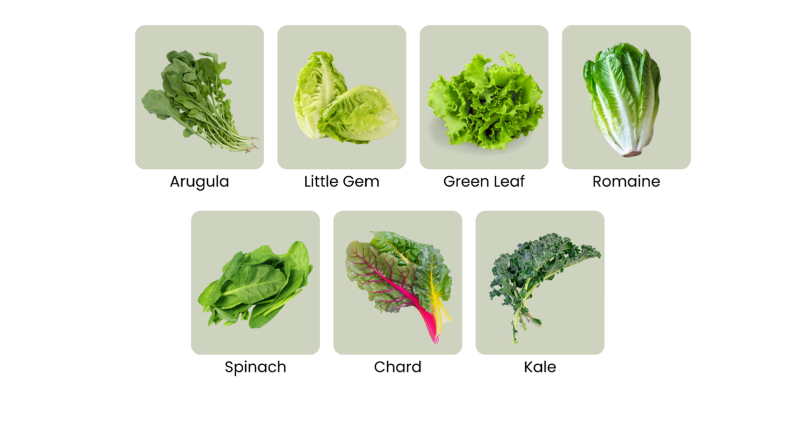
Other non-starchy vegetables add even greater texture, flavor, and nutritional benefit to your salad. Fruits, especially when in season, lend sweetness and added fiber to salads. Check out our recent blog, Eat the Rainbow, to learn more about the specific nutritional benefits and phytonutrients associated with different colored produce. Here are some easy vegetables and fruits to add to your salad (amounts shown are standard serving sizes):
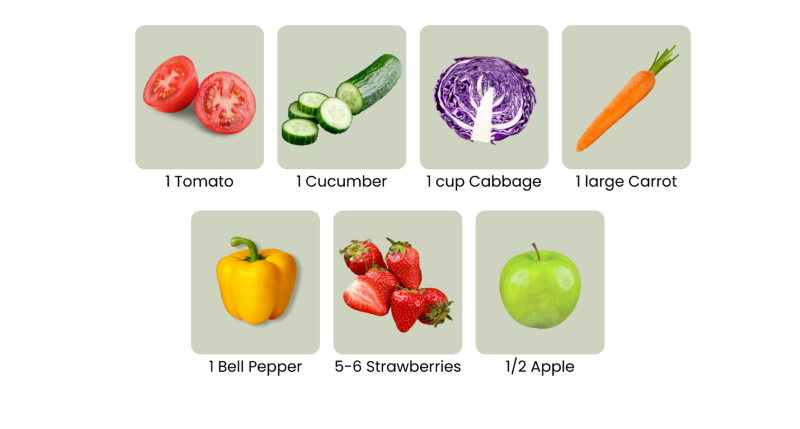
2. LEAN PROTEIN
Lean protein is an important component of your salad because it promotes fullness and aids the body in recovery from exercise or other physical activity. Generally speaking, we recommend including ~20-30 grams of protein at each meal, though this varies based on an individual’s goals and needs. When having a salad as your entrée, we also recommend choosing an efficient protein (a food that has a high protein-to-calorie ratio), such as chicken, turkey, fish, eggs, or tofu. While other foods, such as nuts and cheese, offer protein (between 6-8g per 1oz serving), their higher fat and calorie amounts relative to their protein content make them less efficient protein sources for a meal. When combined with fiber-rich legumes (e.g., lentils, beans) or other lean proteins, however, these protein-containing fats can be a valuable and delicious component of your salad (see more on healthy fats below). Here are a few lean proteins we recommend:
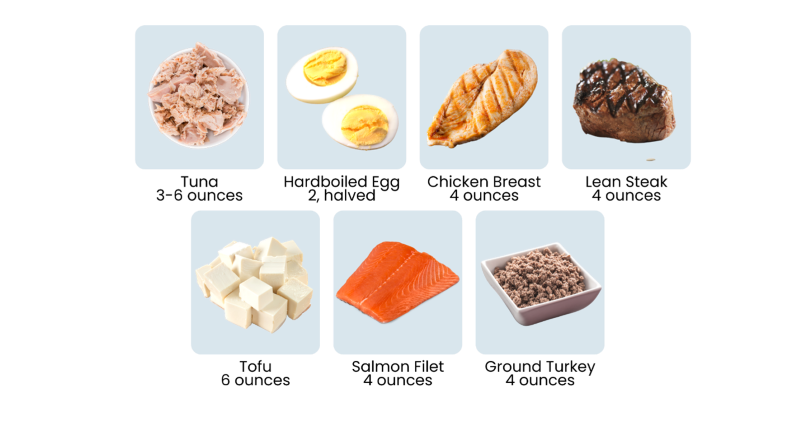
3. COMPLEX CARBOHYDRATE
Carbohydrates are easily the most forgotten component of a salad since many individuals assume salads should be a ‘low-carbohydrate’ meal. However, complex carbohydrates contain beneficial fiber and result in sustained energy. Complex carbohydrates also add texture and crunch to your salad. Here are a few examples of high-quality, high-fiber complex carbohydrates we recommend to optimize these benefits:
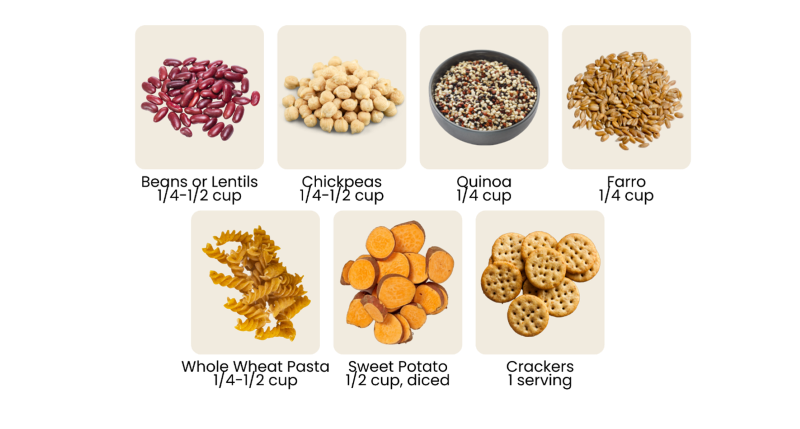
4. HEALTHY FAT
Healthy fats enhance flavor, stabilize blood sugar, and contribute to satiety, making them an important component of salads. Since healthy fats are calorie-dense, it is important to moderate portions when building a salad. To make this easier, we generally recommend limiting to two fat components, including dressing. We all know that a salad dressing makes or breaks a salad. There is an incredible range of salad dressings on the market with varying amounts of calories and saturated fat. To keep your salad balanced, we recommend looking for dressings with less than 100 calories per 2 tablespoon serving. Some of our favorite brands include, but are not limited to: Boathouse Fields®, Newman’s Own®, Brianna’s®, Annie’s Naturals®, Marzetti®, and Primal Kitchen®. For a few healthy fat options we recommend, see below:
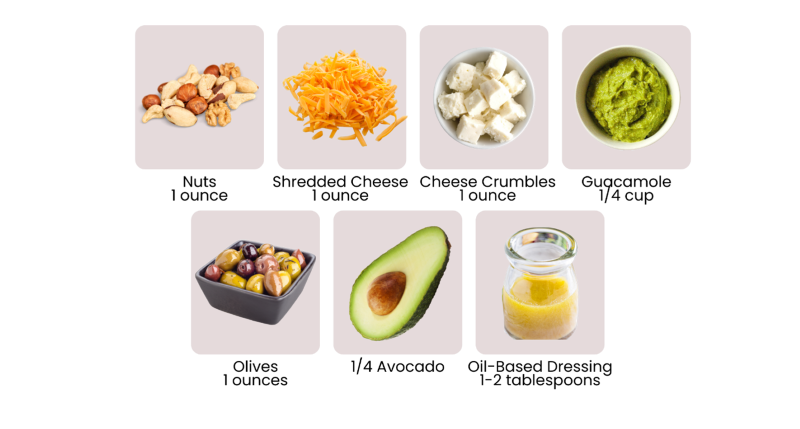
WHERE DO I START?
Now that you know the Four Components of a Balanced Salad and examples of foods in each category, it is time to put it all together. Remember to take your own taste preferences into consideration and make your salads enjoyable – the possibilities are endless! Here are 5 easy salad combinations to get you started.
Strawberry Spinach Salad

Greek Pasta Salad

Steak Fajita Salad

Turkey Burger Salad

Autumn Farro Apple Salad

If you have questions about how to include more salads in your diet and for more individual recommendations, reach out to your SHIFT Registered Dietitian.
In Real Health,
Rachel Klomstad & Lauren Munson
SHIFT Registered Dietitians
© SHIFT MMXXII
The entire contents of this SHIFT material (“Content”), including all text, graphics, images, and other material contained herein are for informational purposes only and do not constitute medical advice; the Content is not intended to be a substitute for professional medical advice, diagnosis, or treatment. Always seek the advice of a physician or other qualified health provider with any questions you may have regarding a medical condition. Never disregard professional medical advice or delay in seeking it because of the messages provided. SHIFT does not endorse or recommend any commercial products, processes, or services. Therefore, mention of commercial products, processes, or services cannot be construed as an endorsement or recommendation.
SHIFT Sciences LLC is a limited liability company that administers services exclusively for SHIFT Medical, Ltd. SHIFT Sciences LLC is not licensed to practice medicine and must contract with professional entities and/or licensed physicians to provide medical services to clients and members. SHIFT Medical, Ltd. is a professionally licensed corporation solely owned by U.S. licensed physicians that employs or otherwise contracts with physicians and medical professionals licensed to practice medicine. Shift Medical Ltd. purchases administrative services from Shift Sciences LLC to assist with the operational and administrative functions related to providing medical services to clients and members.
